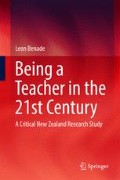Abstract
The conceptualisation, design and construction of new spaces of learning is one of the tangible manifestations of the shift to twenty-first century learning. These reconceptualised spaces bring together multiple groups of students who previously would have made up single classes, with multiple teachers, who previously would have taught their own classes as individuals. The research participants in this study work in a policy milieu with which they engage. This chapter considers some key documentary evidence supporting the property policy direction of the New Zealand Ministry of Education. Against this background, the perspective of the participants clarifies what evolving spatiality means for being a teacher in the second decade of the twenty-first century.
Access this chapter
Tax calculation will be finalised at checkout
Purchases are for personal use only
Notes
- 1.
- 2.
The report indicates that direct quotes from participants are in italicised text. The text relating to students (on p. 9) is all italicised, and apart from its adult language usage, its register reflects a third person, reporting style. This indicates adults reporting what they have heard students say, or what they have witnessed of student conduct in the spaces.
- 3.
The spending allocated to the education sector in the annual Budget, usually tabled in the House of Parliament during May of each year by the sitting government.
- 4.
Green Star is a tool that rates and communicates the sustainability of New Zealand’s commercial buildings. See https://www.nzgbc.org.nz/Category?Action=View&Category_id=217.
- 5.
The ‘Nelson blocks’ of the 1950s broke away from long rows of classrooms accessed by an external corridor. This design provided small self- contained blocks of six teaching rooms on one level, with a duplicate second level subsequently added to these designs. This design minimised student movement and eliminated corridor noise (McLintock 1966, “Modern Planning”).
- 6.
Refer to Chap. 3 for a fuller discussion of this triadic formulation.
References
Blackmore, J., Bateman, D., Loughlin, J., O’Mara, J., & Aranda, G. (2011). Research into the connection between built learning spaces and student outcomes literature review, paper No. 22 June. State of Victoria (Department of Education and Early Childhood Development). Retrieved from http://www.education.vic.gov.au
Byers, T. K. (2016). Evaluating the effects of different classroom spaces on teaching and learning. Doctoral thesis, The University of Melbourne, Melbourne, Australia). Retrieved from http://hdl.handle.net/11343/115307
Chapman, A., Randell-Moon, H., Campbell, M., & Drew, C. (2014). Students in space: Student practices in non-traditional classrooms. Global Studies of Childhood, 4(1), 39–48. doi:10.2304/gsch.2014.4.1.39
Cleveland, B., & Fisher, K. (2014). The evaluation of physical learning environments: A critical review of the literature. Learning Environments Research, 4(17), 1–28. doi:10.1007/s10984-013-9149-3
Dumont, H., & Istance, D. (2010). Analysing and designing learning environments for the 21st century. In H. Dumont, D. Istance & F. Benavides (Eds.), The nature of learning: Using research to inspire practice (pp. 19–34). Paris, France: Organisation for Economic Cooperation and Development Publishing. doi:10.1787/9789264086487-3-en
Fisher, K. (2005). Linking pedagogy and space [slide presentation]. Retrieved from http://www.education.vic.gov.au/Documents/school/principals/infrastructure/pedagogyspace.pdf
Green, H., Facer, K., Rudd, T., Dillon, P. & Humphreys, P. (2005). Personalisation and digital technologies. Bristol, England: Futurelab. Retrieved February 6, 2016 from http://www.nfer.ac.uk/publications/FUTL59/FUTL59_home.cfm
Heppell, S. (2016). Total learning. Retrieved February 21, 2016 from http://rubble.heppell.net/three/
Kyriacou, C. (2001). Teacher stress: Directions for future research. Educational Review, 53(1), 27–35. doi:10.1080/00131910120033628
Lefebvre, H. (1991). The production of space. (D. Nicholson-Smith, trans.). Malden, MA: Blackwell.
McGregor, J. (2004). Spatiality and the place of the material in schools. Pedagogy, Culture and Society, 12(3), 347–372. doi:10.1080/14681360400200207
McLintock, A. H. (Ed.) (1966). Modern Planning. From An Encyclopaedia of New Zealand, republished in Te Ara - the Encyclopedia of New Zealand, updated 22 April 2009. Retrieved 12 August 2015 from http://www.TeAra.govt.nz/en/1966/architectureschool-buildings/page-4
Ministry of Education. (2007). The New Zealand curriculum. Wellington, New Zealand: Learning Media Limited. Available from http://nzcurriculum.tki.org.nz/The-New-Zealand-Curriculum
Ministry of Education. (2011). The New Zealand school property strategy 2011–2021. Retrieved from http://www.education.govt.nz/assets/Documents/Primary-Secondary/Property/SchoolPropertyStrategy201121.pdf
Ministry of Education. (2012). Learning studio pilot review. Retrieved from http://www.education.govt.nz/assets/Documents/Primary-Secondary/Property/School-property-design/Flexible-learning-spaces/LearningStudioPilotReview.pdf
Ministry of Education. (2016). Property. Retrieved June 5, 2016 from http://www.education.govt.nz/school/property/
Moore, G. T. & Lackney, J. A. (1993). School design: Crisis, educational performance and design applications. Children’s Environments, 10(2), 99–112. www.jstor.org
Nair, P. (2014). Blueprint for tomorrow: Redesigning schools for student-centered learning. Cambridge, MA: Harvard Education Press.
Nair, P., Fielding, R., & Lackney, J. (2013). The language of school design: Design patterns for 21 st century schools (3rd ed.). Minneapolis, MN: DesignShare.
Nielsen, A. C. (2004). Best practice in school design (No. 1407454/1407463). Report Prepared For the Ministry of Education. Wellington, New Zealand: Ministry of Education.
Reh, S., & Temel, R. (2014). Observing the doings of built spaces. Attempts of an ethnography of materiality. Historical Social Research, 39(2), 167–180. doi:10.12759/hsr.39.2014.2.167-180
Soja, E. W. (1989). Postmodern geographies: The reassertion of space in critical social theory. London, United Kingdom/New York, NY: Verso.
Thornburg, D. (2007). Campfires in cyberspace: primordial metaphors for learning in the 21st century. Retrieved from http://tcpd.org/Thornburg/Handouts/Campfires.pdf
Woolner, P., McCarter, S., Wall, K., & Higgins, S. (2012). Changed learning through changed space: When can a participatory approach to the learning environment challenge preconceptions and alter practice? Improving Schools, 15(1), 45–60. doi:10.1177/1365480211434796
Author information
Authors and Affiliations
Corresponding author
Rights and permissions
Copyright information
© 2017 Springer Nature Singapore Pte Ltd.
About this chapter
Cite this chapter
Benade, L. (2017). The Impacts on Teachers’ Work: Working in Flexible Learning Environments. In: Being A Teacher in the 21st Century. Springer, Singapore. https://doi.org/10.1007/978-981-10-3782-5_5
Download citation
DOI: https://doi.org/10.1007/978-981-10-3782-5_5
Published:
Publisher Name: Springer, Singapore
Print ISBN: 978-981-10-3781-8
Online ISBN: 978-981-10-3782-5
eBook Packages: EducationEducation (R0)

